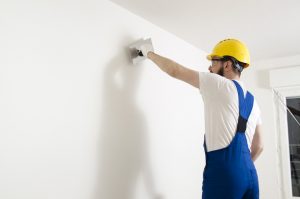 When it comes to wall coverings, there are not many options. Most homeowners will choose between drywall and plaster, with a few variations in materials between them. For the most part, choosing what to cover your walls with comes down to preference for materials, but before drywall arrived on the scene, plaster was the only choice.
When it comes to wall coverings, there are not many options. Most homeowners will choose between drywall and plaster, with a few variations in materials between them. For the most part, choosing what to cover your walls with comes down to preference for materials, but before drywall arrived on the scene, plaster was the only choice.
Before Drywall
Drywall is a more modern, cheaper alternative to plaster. It is easier to install and cheaper to produce, but that does not make it an inferior product. However, for homes built before the 1950’s, there were not many options beyond plaster walls. Even in smaller homes, plaster was the only option, so it was not considered a luxury wall covering like it is today.
Plaster walls come with a number of advantages, namely noise dampening, fire resistance, and longevity. Since plaster is a mix of materials, the composition of the final product may vary based on the location it is produced. Since plaster is a great insulator, it is often seen in many modern homes, but the composition will vary depending on the desired outcome.
Applying Plaster
Unlike drywall, installing plaster is a fairly involved process. It must be applied to a lath to ensure the integrity of the wall. Several coats of varying materials are then applied, each with a different function.
The first coat serves to anchor the plaster to the lath and form a solid base. The second acts as the bond between the final coat and the initial coat, and the final coat is the coat that is shown to the world. This final coat can be customized with unique designs or simply whitewashed and covered with wallpaper, like the homes of the 1900’s.
Applying plaster requires a professional touch, and poorly applied plaster can lead to issues with water leakage, poor insulation, and cracks. Since plaster walls tend to crack over time, it is crucial to ensure it is applied properly in the first place.
Maintaining Plaster
If you are looking to install or maintain plaster in your home, there are a few things to keep in mind. Plaster will develop stress cracks over time, specifically around high traffic areas. These can be repaired by a professional with no lasting damage.
If you are looking to strip paint, a professional can help you remove the paint to ensure new paint adheres to the surface. Unlike drywall, any scraping or damage needs to be filled and repaired properly to prevent cracking.
In new and old homes plaster is a fantastic choice to ensure a smooth finish and lower bills, but make sure you take care of it properly by working with a professional.
Want to learn more about plaster? Check out our other blogs on the composition of plaster and what is involved in installing it. If you are looking to have plaster installed in your home, give us a call, we would be happy to work with you on a renovation or remodel.
